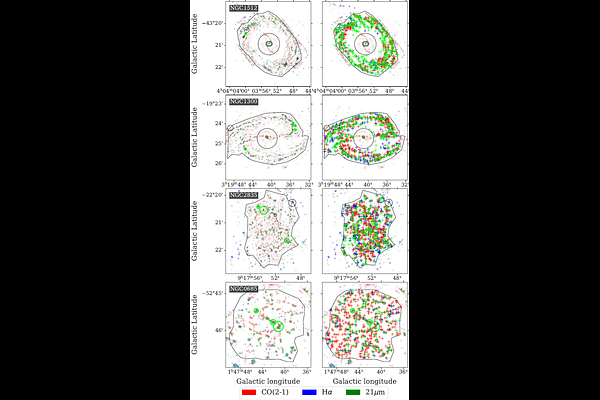Duration and properties of the embedded phase of star formation in 37 nearby galaxies from PHANGS-JWST

Duration and properties of the embedded phase of star formation in 37 nearby galaxies from PHANGS-JWST
Lise Ramambason, Mélanie Chevance, Jaeyeon Kim, Francesco Belfiore, J. M. Diederik Kruijssen, Andrea Romanelli, Amirnezam Amiri, Médéric Boquien, Ryan Chown, Daniel A. Dale, Simthembile Dlamini, Oleg V. Egorov, Ivan Gerasimov, Simon C. O. Glover, Kathryn Grasha, Hamid Hassani, Hwihyun Kim, Kathryn Kreckel, Hannah Koziol, Adam K. Leroy, José Eduardo Méndez-Delgado, Justus Neumann, Lukas Neumann, Hsi-An Pan, Debosmita Pathak, Karin Sandstrom, Sumit K. Sarbadhicary, Eva Schinnerer, Jiayi Sun, Jessica Sutter, David A. Thilker, Leonardo Ubeda, Tony D. Weinbeck, Thomas G. Williams, Bradley C. Whitmore
AbstractLight reprocessed by dust grains emitting in the infrared allows the study of the physics at play in dusty, embedded regions, where ultraviolet and optical wavelengths are attenuated. Infrared telescopes such as JWST have made it possible to study the earliest feedback phases, when stars are shielded by cocoons of gas and dust. This phase is crucial for unravelling the effects of feedback from young stars, leading to their emergence and the dispersal of their host molecular clouds. Here we show that the transition from the embedded to the exposed phase of star formation is short (< 4 Myr) and sometimes almost absent (< 1 Myr), across a sample of 37 nearby star-forming galaxies, covering a wide range of morphologies from massive barred spirals to irregular dwarfs. The short duration of the dust-clearing timescales suggests a predominant role of pre-supernova feedback mechanisms in revealing newborn stars, confirming previous results on smaller samples and allowing, for the first time, a statistical analysis of their dependencies. We find that the timescales associated with mid-infrared emission at 21 {\mu}m, tracing a dust-embedded feedback phase, are controlled by a complex interplay between giant molecular cloud properties (masses and velocity dispersions) and galaxy morphology. We report relatively longer durations of the embedded phase of star formation in barred spiral galaxies, while this phase is significantly reduced in low-mass irregular dwarf galaxies. We discuss tentative trends with gas-phase metallicity, which may favor faster cloud dispersal at low metallicities.